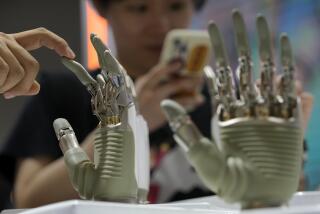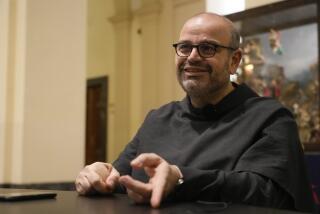Decades Later, a PC Visionary’s Views Continue to Bewilder Some
Technology spin masters have debased few words more than “revolutionary.” But last week, a symposium at Stanford University commemorated a moment in the history of technology that really did change everything.
On Dec. 9, 1968, Doug Engelbart showed the computing world its future.
He began his most famous of demos with this question: “If you in your office, you as an intellectual worker, were supplied with a computer display backed up by a computer that was always alive and was instantly responsive to every action you have, how much value can you derive from it?”
Consider that in 1968 “computer” meant a large, astronomically expensive box ministered to by high priests of engineering. “Interface” referred to paper cards with holes punched in them. The IBM PC would emerge in 13 years, the Macintosh in 15.
Engelbart skipped several evolutionary stages, showing a computer that was like a human among Neanderthals. It used three input devices: a keyboard, a mouse (one Engelbart invention whose basic design survives today) and a five-key pad that with combinations of strokes offered the full range of characters on a standard keyboard.
He also demonstrated video conferencing in an on-screen window, word processing, a drawing program and collaborative editing of documents over a network-complete with variable levels of control.
Alan Kay, himself a luminary for his work at the Xerox Palo Alto Research Center and then Apple Computer, uses the terms “romance” and “destiny” to describe the demo.
“It was one of the greatest experiences I’ve had in my life because it was the totality of the vision,” Kay said.
“To me, [Engelbart] was Moses opening the Red Sea,” he said. “It reset the whole conception of what was reasonable to do with personal computing.”
About 2,000 geeks, students, journalists, technology groupies and true believers nodded at Kay’s words, remembering the moment or being drawn into the sense of awe.
Still, most speakers at the symposium, titled “Engelbart’s Unfinished Revolution,” lamented how slowly and incompletely his larger vision--driving human effectiveness to ever-higher levels--has progressed. Nearly everything he showed came to market--after a delay of 10 to 25 years. But something central to useful innovation seemed lost in the frantic rush to make a buck on PCs and the Web.
“Our ability to do software for any purpose, and particularly for human purposes, is incredibly low,” said Kay, taking a thinly veiled slap at Microsoft’s Bill Gates. The crowd clearly agreed with his suggestion that the dominating mediocrity of Microsoft Windows and Office retard innovation.
“Word processing is a geek’s notion of what writing should be,” said Ted Nelson, a hypertext innovator, explaining why video games are so much better designed than office software. “Video games are designed by people who love to play video games. Office software is designed by people who want to be doing something else on the weekend.”
Ironically, Engelbart should share the blame for the industry taking decades to grapple with his pioneering work.
For all of his genuinely high-minded ideas about collaboration, Engelbart was a control freak. Brilliant scientists flocked to his vision but many left in frustration over his reluctance to make amazing technology adapt to people rather than the other way around.
(His five-key input device was one example--a lucid idea that would be copied by the makers of keyboard alternatives for people with repetitive stress injury. After only a few months of practice, you can use it to type acceptably fast.)
Engelbart disciples found homes at Xerox PARC and Apple, which ultimately developed his ideas for the masses.
Undaunted, in recent years Engelbart has taken on an even more ambitious goal: helping people improve performance by catching up with rapidly changing technology.
“Some day, we will have individuals or teams that vastly outperform what we see today,” he said in an interview. “I call them higher-IQ organizations.” Such organizations would operate by “augmenting rather than automating” their tasks and procedures, Engelbart said.
In a presentation to the symposium, Engelbart talked about putting “discipline into the evolutionary process” for what he called “human systems”--social organizations that operate on qualities like culture, intelligence, custom and skill. He wants to help people more effectively collaborate and exploit “tool systems” that create a vast “dynamic central knowledge base” changing at the pace of an electron in a microcircuit.
His nonprofit organization, the Bootstrap Institute in Fremont, Calif., exists to train technology SWAT teams to help organizations “target collective IQ for aggressive improvement” for “increasingly faster and smarter product cycles as well as faster and smarter improvement cycles.”
But something bothers me about the concept, even beyond the vague catch phrases and the incomprehensible flow charts he showed that contrasted so sadly with the clarity and power of 1968.
Elevating the collective IQ to sync up humans and machines has an insidious side: It accepts technology as the inexorable pacesetter. The person again conforms to the machine. There’s a reason people are often such a tiresome drag on technological progress, refusing to jump on the bandwagon of a beneficent digital future: They cling to human emotions, qualities and rhythms that technology brushes aside.
Thirty years ago, people instantly grasped that Engelbart was right. This time, the audience seemed bewildered. And not a single corporation has yet to adopt his methods.
Still, given the experience with his first set of ideas, I’d give this one some time to germinate. Check this space in 30 years.
*
Times staff writer Charles Piller can be reached via e-mail at charles.piller@latimes.com.






